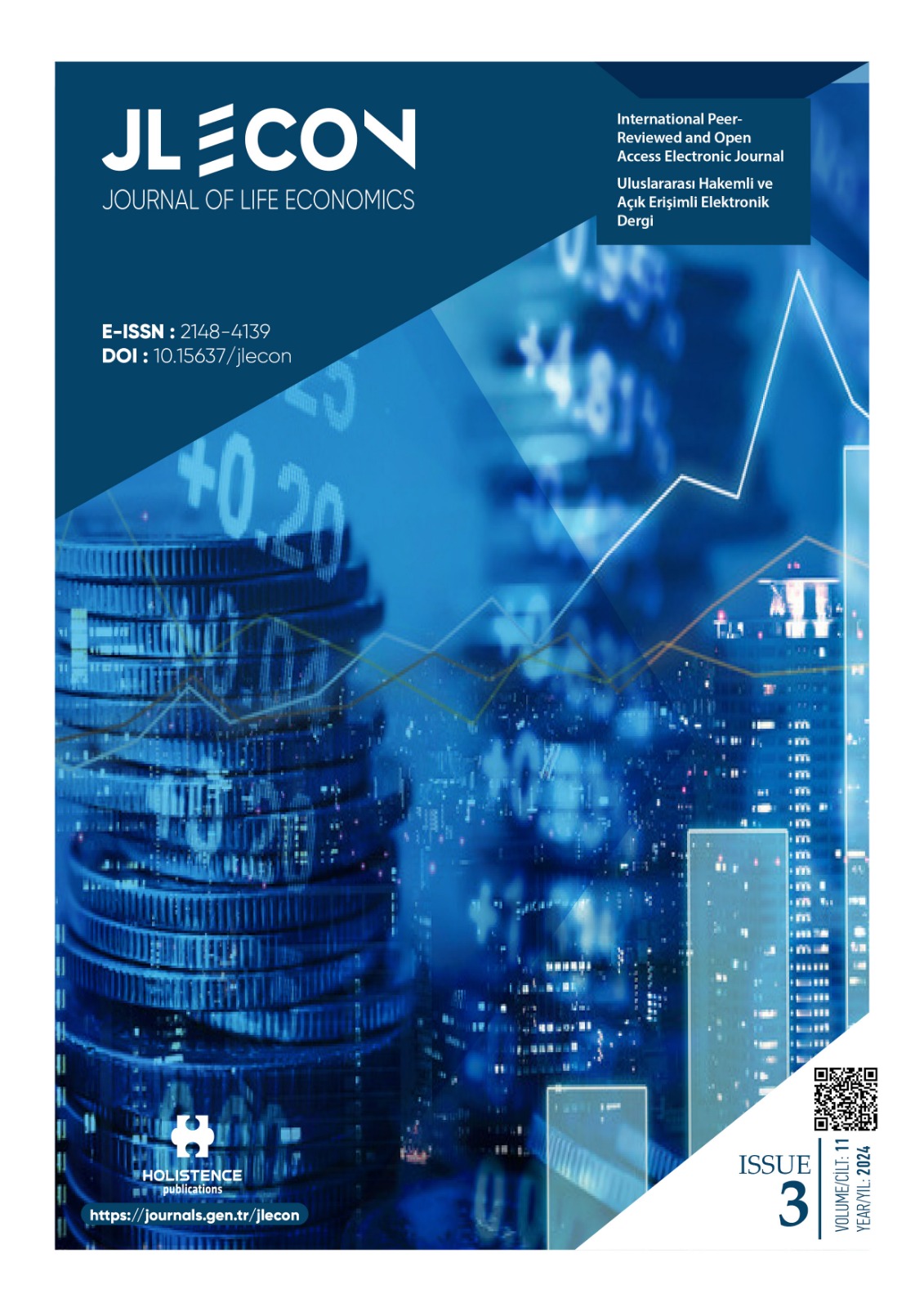Analysis of Instagram adverts in the context of user experiences within the framework of surveillance capitalism
DOI:
https://doi.org/10.15637/jlecon.2483Keywords:
Surveillance Capitalism, Media, Social Media, Instagram, Social Media AdsAbstract
The name of this phenomenon, which sees users as products and turns their spending time on social networks or websites without doing anything into financial income, is: Surveillance capitalism. Every step users take, everything they do to spend time, whether necessary or unnecessary, turns into data, and this data is monetised by selling it to companies or advertisers. The best performers of the function of monetising user data are global companies such as Meta, Microsoft and Google, whose applications, websites and social networking sites are used by many people in their daily lives. Every step users take, everything they do to spend time, whether necessary or unnecessary, turns into data, and this data is monetised by selling it to companies or advertisers. Global companies such as Meta, Microsoft and Google, whose applications, websites and social networking sites are used by many people in their daily lives, are the best at monetising user data. These companies, which are at the forefront of surveillance capitalism, sell the data they obtain from users to all companies that want to sell something on the internet. Surveillance capitalism deploys many technologies, but it cannot be equated with any technology. Its activities may involve platforms, but these activities are not the same as platforms. It engages machine intelligence, but cannot be reduced to machines. It produces and relies on algorithms, but it is not the same as algorithms. In the context of these definitions, the study aims to reveal the effort to understand the laws of surveillance capitalism, which affects the lives of individuals in many ways, through the experiences of individuals.
The findings indicate that surveillance capitalism influences user experiences through social media platforms such as Instagram as a post-panoptic tool, and also reveals more effective advertising strategies by monitoring and analysing consumer behaviour.
Downloads
References
AKGÜN AKAN, N. (2020). Reklamın Değişen Yüzünde Çevrimiçi Davranışsal Reklamcılık: İnternet Kullanıcıları Perspektifinden Bir Araştırma. (Tez no: 610787) [Yayımlanmamış Doktora Tezi. Erciyes Üniversitesi] https://tez.yok.gov.tr/UlusalTezMerkezi/tezSorguSonucYeni.jsp
BLOOM, P. (2019). Monitored: Business and Surveillance in a Time of Big Data, London: Pluto Press.
DABBAGH N. & KİTSANTAS A. (2011), Personal Learning Environment, social media, and self-regulated learning: A natural formula for connecting formal and informal learning, Internet and Higher Education, doi: 10.1016/j.iheduc.2011.06.002
DEMİRTAŞ, Z. G. (2019). Geleneksel Medyadan Yeni Medyaya Kanaat / Kamuoyu Önderleri (Yayın no. 615466) [Doktora Tezi, Gazi Üniversitesi] https://tez.yok.gov.tr/UlusalTezMerkezi/tezSorguSonucYeni.jsp
GOLD, H. J. (2015). The Digital Advertising Guide. Allston, USA: Overdrive Marketing Communications LLC.
GRAY, C. H. (2019). The threat of surveillance capitalism. Teknokultura. Revista de Cultura Digital Movimientos Sociales, 16 (2), 265-276.
HAMİD S, CHANG S & KURNİA S. (2009). “Identifying the Use of Online Social Networking (OSN) in Higher Education. Same places, different spaces. Proceedings Ascilite.” Auckland, 419-422.
HU, Y., MANİKONDA, L. & KAMBHAMPATİ, S. (2014). What We Instagram: A First Analysis of Instagram Photo Content and User Types, Proceedings of the Eight International AAAI Conference on Weblogs and Social Media.
KİM, J. U., KİM, W. J. & PARK, S. C. (2010a). Consumer perceptions on web advertisements and motivation factors to purchase in the online shopping. Computers in human behavior, 26(5), 1208-1222.
KOÇOĞLU, S. (2018). Instagram Tarihi: Instagram Nedir? Nasıl Kullanılır? Ne İşe Yarar? 28 Ocak 2023’te https://www.brandingturkiye.com/instagram-tarihi-instagram-nedir-nasil-kullanilir-ne- ise-yarar/ adresinden indirildi.
MAYER-SCHÖNBERGER, V. & CUKİER , K. (2013). Büyük Veri: Yaşama, Çalışma ve Düşünme Şeklimizi Dönüştürecek Bir Devrim, çev. Banu Erol, 1. bs, İstanbul: Paloma Yayınları.
MESTÇİ, A. (2013). İnternette Reklamcılık. İstanbul: Pusula Yayıncılık.
ÖNAY DOĞAN, B. (2015). Online Reklamcılık. İstanbul: Köprü Kitapları.
ÖZTÜRK, R. G. (2013). Dijital Reklamcılık ve Gençlik. (1.baskı), içinde (7). İstanbul: Beta Basım Yayınları.
SAYIMER, İ. (2008). Sanal Ortamda Halkla İlişkiler. İçinde (123). İstanbul: Beta Yayınları.
ULUK, M. (2022). Gözetı̇m Kapı̇talı̇zmı̇nde Kı̇şı̇sel Verı̇lerı̇n Kullanımı: Etı̇k Web Çerçevesı̇nde Web Sı̇telerı̇ Ve Mobı̇l Uygulamalar Üzerı̇ne Bı̇r Araştırma (Yayın No. 714174). [Doktora Tezi, İstanbul Üniversitesi]. https://tez.yok.gov.tr/UlusalTezMerkezi/tezSorguSonucYeni.jsp
UMUTONİ, L. (2021). Dijital Reklamcılık ve Z Kuşağı: Z Kuşağının Online Davranışsal Reklamcılık ile İlgili Görüşlerinin Analizi. [Yayımlanmamış Yüksek Lisans Tezi. Akdeniz Üniversitesi] https://tez.yok.gov.tr/UlusalTezMerkezi/tezSorguSonucYeni.jsp
VAN DİJK, J. (2008). Ağ Toplumu. İstanbul: Kafka-Epsilon Yayıncılık.
VARNALI, K. (2012). Dijital Tutulma: Pazarlama İletişimi ve İnsan. İstanbul: MediaCat Kitapları.
YURTTAŞ, Ö. U. (2011). Sosyal Medya Ortamı Olarak Second Life’da Yayınlanan Reklamların Marka Bilinirliğindeki Rolü. (Yayın No. 290815). [Doktora Tezi, Marmara Üniversitesi]. https://tez.yok.gov.tr/UlusalTezMerkezi/tezSorguSonucYeni.jsp
ZİCHKUR, K. & SMİTH, A. (2012). Digital differences', Retrieved from: http://alexa.pewinternet.com/~/media/Files/Reports/2012/PIP_Digital_differences_0413 12.pdf.
ZUBOFF, S. (2015). "Big Other: Surveillance Capitalism and the Prospects of an Information Civilization." Journal of Information Technology 30, no. 1: 75–89.
ZUBOFF, S. (2019). The Age of Surveillance Capitalism: The Fight for a Human Future at the New Frontier of Power. New York: PublicAffairs.
Downloads
Published
How to Cite
Issue
Section
License
Copyright (c) 2024 Holistence Publications

This work is licensed under a Creative Commons Attribution 4.0 International License.
When the article is accepted for publication in the Journal of Life Economics, authors transfer all copyright in the article to the Holistence Publications.The authors reserve all proprietary right other than copyright, such as patent rights.
Everyone who is listed as an author in this article should have made a substantial, direct, intellectual contribution to the work and should take public responsibility for it.
This paper contains works that have not previously published or not under consideration for publication in other journals.

















